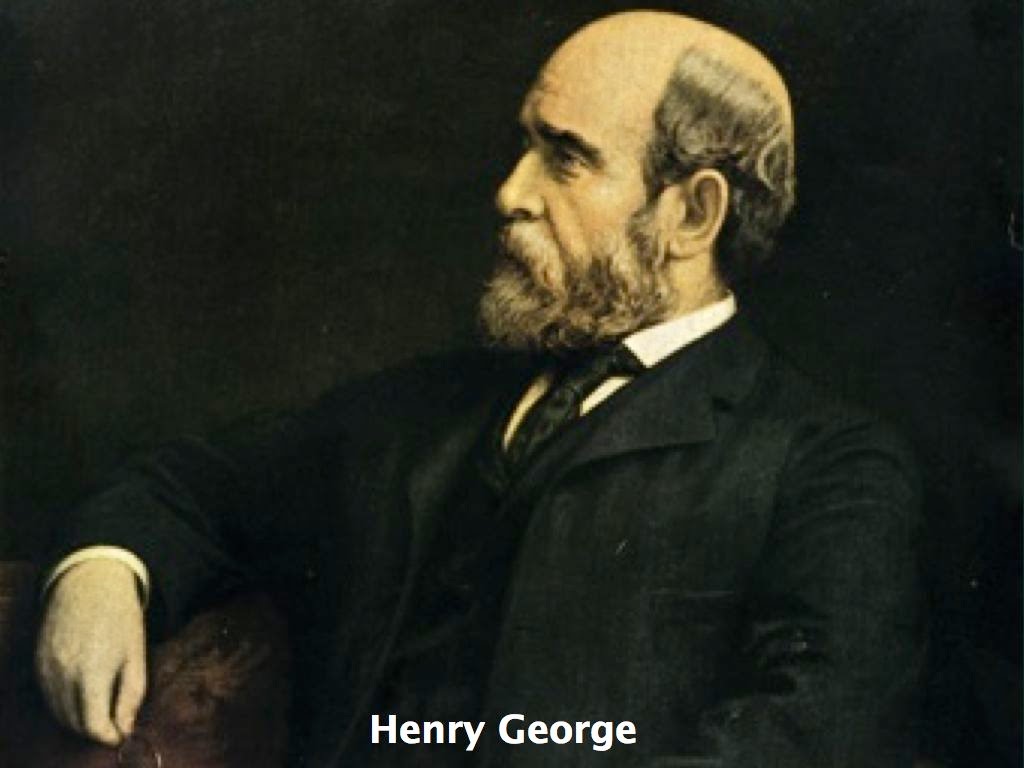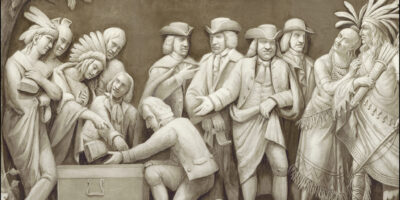The Amazing Influence of Henry George (on E.C. Harwood)
If you read the history of American political economy, particularly from the 1880s through the 1930s, Henry George (1839-1897) is a name you can’t miss. His influence was profound, and especially notable on the thinking of two of my favorites: Albert Jay Nock and Frank Chodorov. Another scholar who was so influenced: E.C. Harwood, founder of the American Institute for Economic Research. From my reading, he could rightly be considered within the broad umbrella of free-market Georgists.
“Henry George’s work is both scholarly and scientific,” wrote Harwood. “The importance of his principle ‘discovery,’ which he chose to call ‘the law of human progress,’ can hardly be overestimated. I do not see how any society that fails to understand and apply the principles of freedom and justice can hope to flourish. His work has stood the test of time and has demonstrated that it has little to fear from its enemies…. There will be a rebirth of freedom, an increasing realization that progress toward the goals of the Great Revolution must be resumed. When that day comes, we can rest assured that Henry George will be accorded the recognition that is his due.”
Those words were written in 1952. Henry George’s Progress and Poverty, was written in 1879. That a book of political economy could make such a lasting impression is remarkable. The book – hardly even read today – had indeed become the single most influential book on economics during the highest period of economic growth ever recorded. His influence lasted all the way to World War II and only embed in the following decades.
George the Prophet
“The present century has been marked by a prodigious increase in wealth-producing power,” reads the opening salvo of George’s masterwork. This period constituted the Great Revolution, or the Great Enrichment, as Deirdre McCloskey calls it today. Incomes, job opportunities, family size, new technologies, and wealth in general were exploded upwards as never before seen, even as disease, death, and poverty were falling as never before. Even then, many were left behind. It was George’s task to find a way to universalized prosperity.
This was America in the Gilded Age, when growth of 8-15 percent per year was not unusual. The country was on a gold standard. New innovations and their disbursement through the population were dramatically changing the culture and challenging people’s thinking on economics. There were railroads, steel, internal combustion, flight, the telephone, electricity, and huge developments in medicine. It was the birth of modernity as we know it, and George became its leading social and economic thinker.
There was probably not a prominent intellectual in the English-speaking world between the book’s appearance and the 1930s who did not read it. Important public intellectuals praised it, including Albert Einstein, Bernard Shaw, Frank Chodorov, Leon Tolstoy, Philip Wicksteed, F.A. Hayek, John Dewey, and Bertrand Russell, among thousands of others. The praise extended far beyond politics, with free-market radicals and socialists all finding ways to credit his contributions as their primary influence.
The book sold 6 million copies and was translated into 15 languages, becoming the second-best selling book next to the Bible (before Ayn Rand’s Atlas Shrugged displaced it for that title). This notoriety is especially unusual given that George was never formally educated beyond the age of 14. He was a sometime businessman who grew up in poverty, eventually becoming a writer for newspapers. He had no academic standing at all.
The Intellectual Culture
You might think that social science at the time would have come to celebrate the source of all this progress: capital accumulation, trade, ownership, and laissez faire generally. On the contrary, this was a time when the academic classes were enraptured by Marx on the left and the German model of economic planning on the right. They were pushing eugenics. They panicked about immigration. They looked forward to various forms of planning.
In these years, too, we saw the rise of populism with the free silver movement, the resentment against railroad companies and banks, the intensification of attacks on the so-called Robber Barons and so on.
In other words, just as humanity saw the first glimmer of the hope of universal human prosperity, prevailing ruling-class opinion turned against the idea and pushed a host of nostrums to stop it from happening. Here was where Henry George made the difference. He entered into this milieu with a powerful message: prosperity for the entire world is possible provided we keep pushing out the boundaries of freedom, provide no privilege to any single class, we fix the problems that are keeping people in poverty, we address the underlying cause of the boom-bust cycle, and continue to innovate and trade.
“Liberty calls to us again,” he wrote. “We must follow her further; we must trust her fully. Either we must wholly accept her or she will not stay. It is not enough that men should vote; it is not enough that they should be theoretically equal before the law. They must have liberty to avail themselves of the opportunities and means of life; they must stand on equal terms with reference to the bounty of Nature.”
The rejection of liberty – and that includes the push to have government manage the money supply – always means one or another form of despotism.
“The ideas that there is a necessary conflict between capital and labour, that machinery is an evil, that competition must be restrained and interest abolished, that wealth may be created by the issue of money, that it is the duty of Government to furnish capital or to furnish work, are rapidly making way among the great body of the people, who keenly feel a hurt, and are sharply conscious of a wrong. Such ideas, which bring great masses of men, the repositories of ultimate political power, under the leadership of charlatans and demagogues, are fraught with danger.”
George is mostly known today as a proponent of the land tax, but it is not widely understood how much he saw through the racket of the prevailing form of taxation at the time, which was mostly in the form of tariffs and excise taxes (the income tax was yet to be imposed).
“Nearly all of the manifold taxes by which the people of the United States are now burdened have been imposed rather with a view to private advantage than to the raising of revenue, and the great obstacle to the simplification of taxation is these private interests, whose representatives cluster in the lobby whenever a reduction of taxation is proposed, to see that the taxes by which they profit are not reduced.”
Ultimately, wrote George, the path to progress requires the celebration of the freedom of association, ownership, and trade. As he so beautifully wrote:
“Civilisation is co-operation. Union and liberty are its factors. The great extension of association—not alone in the growth of larger and denser communities, but in the increase of commerce and the manifold exchanges which knit each community together, and link them with other though widely separated communities; the growth of international and municipal law; the advances in security of property and of person, in individual liberty, and towards democratic government—advances, in short, towards the recognition of the equal rights to life, liberty, and the pursuit of happiness—it is these that make our modern civilisation so much greater, so much higher, than any that has gone before.”
George’s Popularity
Why was the book so stunningly popular? There was in the world at that time a rising fear of socialist revolution. The socialists were gaining ground in Europe among academia generally, and a widespread fear of an all-out worker revolution was common. George’s passion on the issue of poverty and equality, together with what seemed to be a common-sense solution, offered an alternative to revolutionary upheaval and the imposition of despotism.
He was a much-needed intellectual dissident. He seemed to provide a way to save economic freedom from being overthrown, at once protecting the rights of the wealthy while spreading the benefit of that wealth more broadly among the population. This solution had a huge appeal.
Truly, he lays out a beautiful vision of a liberal economy, universal prosperity, and the moral urgency of freedom. He believed it belonged to all peoples in all times, and he was convinced that it could be had in the new century. In this sense, he defined the very essence of what became the highest aspirations of the best intellectuals of the age.
George’s perspective makes for a striking contrast to the views of other contemporaries, who expressed alarm at the radical demographic changes of the last quarter of the 19th century. This and the hope that his vision inspired was the source of his magic as a writer and intellectual.
The Land Tax
If you know anything about Henry George, it probably isn’t about his advocacy of a laissez faire economy, or his absolute dedication to free association and free trade. It is probably about the land tax. And this is for a reason. In Progress and Poverty, this subject receives vast attention from him.
What was the argument? On technical matters, George sought to address who it is that poverty persists against despite the massive rise of wealth. How could so many make and possess such vast new wealth and yet so many remain in a state of grueling poverty? It was the inequality that struck him, and his casual observation seemed to suggest that the inequality grew even as wealth expanded. He noted that the poor in New York, where wealth was highest, were worse off than they were in California even though the West had far fewer barons of great wealth. How can we account for this? He was also struck by the cycles of boom and bust that caused so much suffering among so many, and speculated on their cause.
His theory was that the untaxed private ownership of land and resources was locking up wealth in a way that it could not be accessed by everyone but its owners. The value of land rose higher and higher, even though its owners were not themselves producing anything. This was particularly true of the railroads, he noted. Wherever the tracks were laid, and the banks appeared, we saw large pockets of wealth appear but it was channelled only to the few who were involved in land speculation. He said that this was due to the fact that land is an example of a fixed resource. It doesn’t grow in supply. So when it becomes more valuable, the rent to the land flows only to its owner, who unjustly benefits while everyone else suffers.
His solution was a broad and sweeping tax on land, which he proposed as a replacement to all other existing taxes, including excise taxes of all sorts and also all tariffs (he was a radical proponent of free trade between nations). This tax, wrote George, would fund the whole of the government in all its operations, and help discourage the monopolization of land in the hands of a few. This would create the conditions for a more widespread sharing of wealth.
What’s crucial here is that George was not in any way a socialist. Though he believed that poverty was traceable to private land, he nowhere proposed the end of private ownership of every sort. Indeed, he was a champion of all forms of private ownership, trade, innovation, and association. He believed that a land tax would perfect the vision of Adam Smith and David Ricardo.
It is crucial to remember, however, that George’s ideas on the land tax were born of a particular time and place, tied to the signs of modernity around him, which, time and again, seemed to be bound up with land and titles to land. He believed he had found the answer to the problem, but didn’t entirely realize that he was coming up with a theoretical answer to what was really a problem isolated to a particular time and bound up with other institutional factors.
The problem with the banks at the time was not the lack of regulation or the freedom to try and fail but rather the implicit guarantees and privileges given to them and their main clients in the government-backed railroad system. These factors contributed mightily to the speculative price bubbles that were roiling the country. This was not a breakage in the market system, much less a symptom of the failings of private land ownership, but precisely what he in other contexts said: the system was not free enough from government grants of monopoly privilege.
His Lasting Influence
Henry George, despite his confused economics and his advocacy of the land tax, was an eloquent and passionate advocate of the free society pushed toward progress through a laissez faire economy. He rallied around the principle of association as the basis for the existence of society as we know it, and the lack of association or its forbidding is the condition that leads to its unraveling. He saw people as an asset that made society more prosperous, and thereby completely rejected the Mathusian idea that more people leads to more poverty.
His massive influence is sometimes credited with many of the reforms of the progressive era, but he is more correctly seen as a critical influence in the development of the 20th century libertarian tradition, as beautifully illustrated in his central influence on E.C. Harwood.
Does he have anything to teach us today? As in the 1880s, humankind is experiencing a massive wave of prosperity. The number of people living in crushing poverty has fallen by half in 20 years. Disease, hunger, violence, and early death are on the decline even as prosperity, health, and access to economic opportunity are on the increase. Even so, academia and the political classes are drawn not to the idea of freedom but to more statism, socialism, and fascism. The culture is proving itself, once again, blind to the relationship between cause and effect.
George’s message that universal human prosperity is obtainable and sustainable is needed as much now as when it was first delivered. Harwood’s prediction may yet prove true, that when civilization again discovers freedom as the source of universal human empowerment, “Henry George will be accorded the recognition that is his due.”











